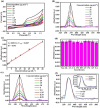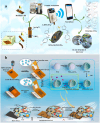Development, fabrication, and applications of laser-induced graphene-based biosensors in food and dairy sectors
- PMID: 40760054
- PMCID: PMC12321947
- DOI: 10.1007/s00604-025-07395-4
Development, fabrication, and applications of laser-induced graphene-based biosensors in food and dairy sectors
Abstract
Laser-induced graphene (LIG) has emerged as a cutting-edge carbon material with a unique porous architecture and superior electrochemical properties. Owing to its promising potential to immobilize various biological analytes, LIG has gained intense interest in the development of next-generation biosensors. Direct laser scribing on natural or polymeric substrate materials produces LIG electrodes with tunable properties, offers controlled microstructures, ease surface modifications, and doping with suitable elements, making it promising for electroanalytical measurements. Furthermore, LIG technology stands out as being cost-effective and supports environmental sustainability and eco-conscious solutions. These diverse features open new frontiers, making it suitable for fundamental applications in diverse fields, particularly in the food and dairy industry, where rapid, on-site, and precise monitoring is vital. This review comprehensively discusses fabrications of LIG-based biosensors with a focus on various laser sources, substrate materials, and surface modifications. The core sensing mechanisms of LIG biosensors are thoroughly summarized which enable high sensitivity and selectivity. However, special attention is given to LIG biosensors' applications in the food and dairy industry for the monitoring of food pathogens, food ingredients, food spoilage, biogenic amines, food additives, antibiotics, chemical contaminants, and pesticides. Finally, this review discusses the current challenges of LIG-based biosensors, such as reproducibility, stability, and integration into commercial industries, while offering a future outlook for potential applications. By highlighting recent advances and summarizing knowledge gaps, this review provides new insights into LIG-based sensors and their applications in the food and dairy industry to ensure food quality and safety.
Keywords: Biosensor fabrication; Biosensors; Food and dairy; Laser-induced graphene; Sensing mechanism.
© 2025. The Author(s).
Conflict of interest statement
Declarations. Competing interests : The authors declare no competing interests.
Figures























Similar articles
-
Management of urinary stones by experts in stone disease (ESD 2025).Arch Ital Urol Androl. 2025 Jun 30;97(2):14085. doi: 10.4081/aiua.2025.14085. Epub 2025 Jun 30. Arch Ital Urol Androl. 2025. PMID: 40583613 Review.
-
Laser material processing for design and fabrication of wearable biosensors and bioelectronics.Biosens Bioelectron. 2025 Nov 15;288:117755. doi: 10.1016/j.bios.2025.117755. Epub 2025 Jul 5. Biosens Bioelectron. 2025. PMID: 40651391 Review.
-
Electrochemical Detection of Heavy Metals Using Graphene-Based Sensors: Advances, Meta-Analysis, Toxicity, and Sustainable Development Challenges.Biosensors (Basel). 2025 Aug 4;15(8):505. doi: 10.3390/bios15080505. Biosensors (Basel). 2025. PMID: 40862966 Free PMC article. Review.
-
Electrochemical detection of foodborne Escherichia coli using carbon nanotube-incorporated pencil-drawn paper-based disposable biosensors.Anal Chim Acta. 2025 Oct 1;1369:344344. doi: 10.1016/j.aca.2025.344344. Epub 2025 Jun 19. Anal Chim Acta. 2025. PMID: 40701715
-
A Review on Laser-Induced Graphene-Based Electrocatalysts for the Oxygen Reduction Reaction in Electrochemical Energy Storage and Conversion.Nanomaterials (Basel). 2025 Jul 10;15(14):1070. doi: 10.3390/nano15141070. Nanomaterials (Basel). 2025. PMID: 40711189 Free PMC article. Review.
References
-
- Nau A et al (2023) Impact of the revision of European food hygiene legislation and the introduction of convenience-based food on food safety in the German military. J Food Prot 86(5):100073 - PubMed
-
- Setti M et al (2025) Sustainable electrochemical sensors from cork-derived laser induced graphene: non-enzymatic glucose detection in urine. Sens Actuators B: Chem 430: 137352
-
- Harun-Or-Rashid M, Mirzaei S, Nasiri N (2025) Nanomaterial innovations and machine learning in gas sensing technologies for real-time health diagnostics. ACS Sens 10(3):1620–1640 - PubMed
-
- Aftab S et al (2024) Laser-induced graphene for advanced sensing: comprehensive review of applications. ACS sensors 9(9):4536–4554 - PubMed
Publication types
MeSH terms
Substances
Grants and funding
LinkOut - more resources
Full Text Sources
